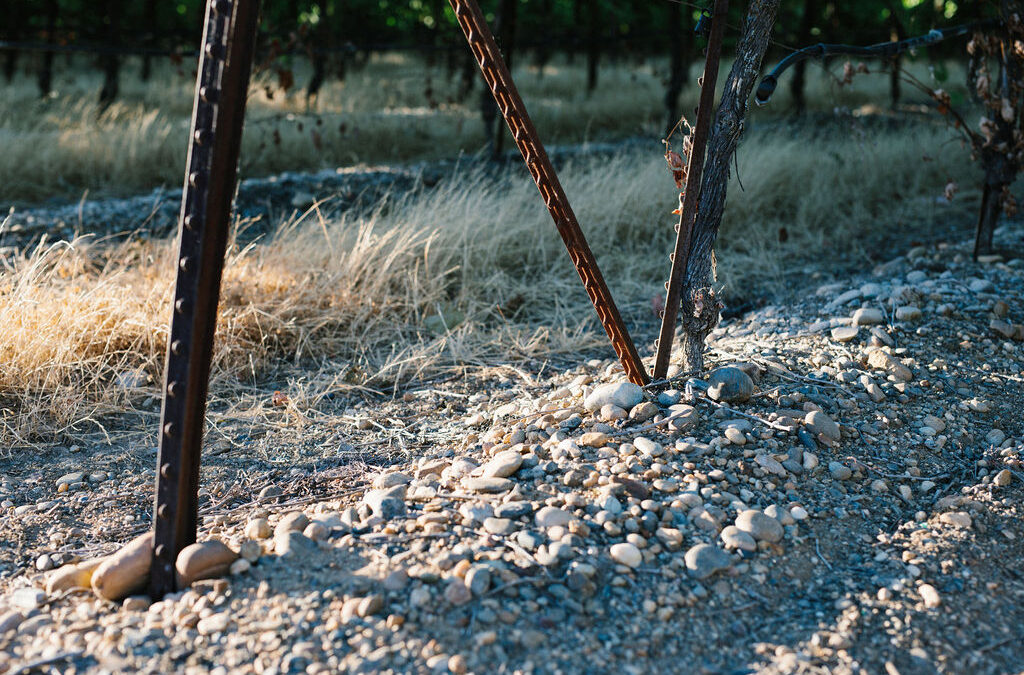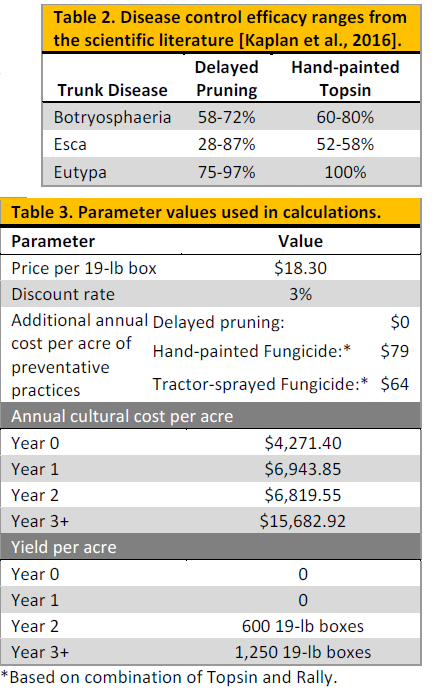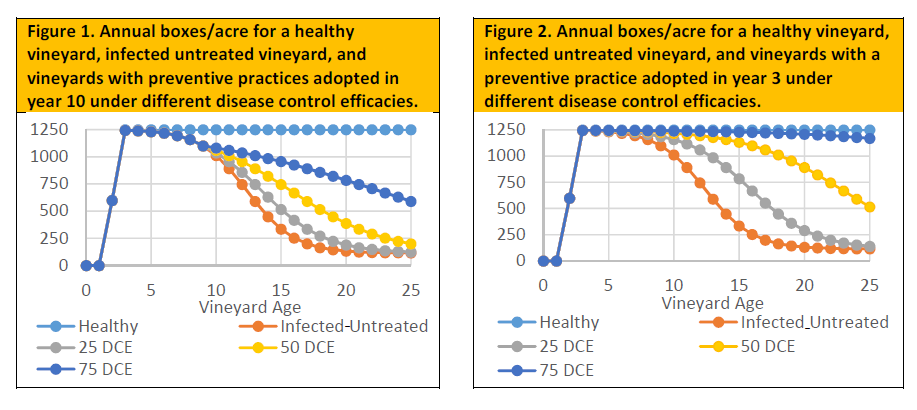MONDAY, APRIL 19, 2021. BY KENDRA BAUMGARTNER, PHD, USDA, JOHNATHAN KAPLAN, PHD, CSU SACRAMENTO, & MAX NORTON, PHD, CSU SACRAMENTO.
California is the nation’s leading grower and sole exporter of table grapes [California Department of Food and Agriculture, 2017], with over 99% of US commercial table grapes grown in California [California Table Grape Commission (CTGC), 2017]. In 2016, the state’s 85,166 bearing acres of commercial table grapes produced 939,294 metric tons of grapes, valued at $1.85 billion [CTGC, 2017; CTGC, 2016]. Most of this acreage is located in the southern San Joaquin Valley.
Trunk, or wood-canker diseases, including Botryosphaeria dieback, Esca, Eutypa dieback, and Phomopsis dieback, present a serious challenge to the productivity of vineyards of all types. The majority of California vineyards over age 10 are likely infected [Hillis et al., 2015]. Rain during the dormant season induces spore production, liberation, and dispersal. The vineyard climatic conditions at this time of year prolong the time it takes for pruning wounds to heal, increasing the susceptibility of the vine. If untreated, yield losses can potentially reach over 90% near the end of a 25-year lifespan [Munkvold et al., 1994]. Further, trunk diseases take many years to develop and do not start to show symptoms until around 10 years old, years after the initial infection has already occurred, at which point management options are limited. Preventative management practices are available (see Table 1), but growers often exhibit hesitancy to start using them in newly established vineyards, possibly due to uncertainties about cost-effectiveness and disease control efficacy (DCE) [Hillis et al., 2015].
Recent research on winegrapes has shown that even late adoption of relatively expensive preventative practices can be expected to lengthen a vineyard’s profitable lifespan and generate net benefits. Earlier adoption, choice of lower-cost practices, and increased efficacy improve both profitable lifespan and net benefits [Kaplan et al., 2016]. This study extends this prior analysis to a representative Crimson Seedless vineyard in the southern San Joaquin Valley growing region of California with a 25-year lifespan so we can determine how beneficial early adoption of these practices might be in table grape vineyards of California.
Key Findings
Adoption of preventative practices in all scenarios results in net benefits per acre that are greater than when pruning wounds are left untreated. When preventative practices are adopted in a ten-year-old vineyard, the net returns remain positive for years longer than when preventative practices are not used, extending the profitable lifespan of the vineyard by 2 to 14 years (a potential lifespan increase of more than 100%). If the practices are adopted even earlier, the profitable lifespan is likely to increase by an additional year or more. In addition, it may take a preventative practice adopted in 3-year old or 5-year old vineyards up to 3 years to outperform an infected vineyard in which no preventative practices are employed due to low levels of disease incidence at these ages. This lag may discourage growers from early adoption, even though it produces greater cumulative net returns over the vineyard’s lifespan. When adoption occurs when the vineyard is 10 years old, the treated vineyard outperforms an infected-untreated vineyard in that year and every year thereafter, given the infection has grown sufficiently large, but cumulative net returns in such a vineyard fall short of those in a vineyard where a preventative practice is adopted in an earlier year.
Methodology
We performed a simulated economic experiment that calculated the cumulative discounted net returns (CDNR) generated over a 25-year lifespan for a representative vineyard producing Crimson Seedless table grapes. CDNR were calculated for preventative management scenarios and compared to a baseline simulation of an infected vineyard in which preventative practices were not practiced. Baseline parameters. The simulated vineyard represents a cane-pruned Crimson Seedless table grape vineyard in California’s southern San Joaquin Valley. We assumed prices, practice costs, and an age-yield profile derived from UC Cooperative Extension Cost and Returns Studies on table grapes [Peacock et al., 2007] and discussion with UCCE farm advisors. Data on yield loss due to infection and on DCE came from the scientific literature on trunk disease. Preventative practices. We considered three preventative practices (delayed pruning, handpainted fungicide, and tractor-sprayed fungicide) with DCE based on findings in the literature as summarized in Kaplan et al. (2016) and displayed in Table 2. We assume similar efficacy rates for tractor-sprayed fungicide as those for hand-painted Topsin given no studies specific to tractor-sprayed fungicides. Per discussions with growers, our estimates of fungicide costs reflect a mixed application of Topsin and Rally. Our core simulations assumed that each practice achieves 50% DCE, while the practices ranged in additional annual cost from $0 to $79 per acre over an untreated vineyard, as seen in Table 3.
Scenarios
Scenarios varied in practice and age of the vineyard when the practice is adopted (year 3, year 5, and year 10), yielding 9 preventative practice scenarios. Following existing literature and field trial results, each scenario’s benefits were calculated for a DCE rate of 50%. We also considered the sensitivity of our results as DCE fluctuates from 25% to 75%. Figures 1 illustrates simulated average yield per acre over 25 years in a healthy table grape vineyard (Healthy), in an infected vineyard where preventative practices were never employed (Infected-Untreated), and in an infected vineyard in which a preventative practice is adopted in year 10, with DCE rates of 25%, 50%, and 75%. Figure 2 shows the analogous outcomes when adoption occurs in year 3. Practices adopted in year 3 and with high efficacy produce yields close to those from a healthy, vineyard with no infected vines. Practices adopted in mature vineyards with low efficacy may see yield losses close to those for an infected-untreated vineyard.
Detailed Results
Over a 25-year lifespan, the adoption of preventative practices consistently generates additional CDNR, when compared to an infected-untreated vineyard. The magnitude of these additional CDNR increases with increases in DCE, with earlier adoption of the preventative practice, and as the cost of the preventative practice falls. Although the additional returns are consistently positive relative to an infected-untreated vineyard, the CDNR over the 25 years may still fall below zero when DCE is low, practice cost is high, or practice adoption does not occur until symptoms appear (year 10). Figure 3 shows the 25-year growth path of CDNR for a healthy vineyard, an infected untreated vineyard, and an infected vineyard in which the hand-painting of fungicide is adopted in year 3, year 5, and year 10, with 50% DCE. By year 10, all alternatives begin to display additional CDNR relative to the scenario of an infected-untreated vineyard. At this cost and efficacy, both year 3 and year 5 adoption of the preventative practice lead to positive CDNR over the entire 25-year horizon. Although year 10 adoption provides a positive return relative to an infected untreated vineyard, the CDNR still becomes negative by year 23. Note that the healthy scenario is provided only as a counterfactual—in California, all established vineyards are presumed to be infected with one or more trunk diseases.
All of the preventative practices studied produce positive CDNR over a 25-year lifespan if they achieve at least 50% efficacy and are adopted by year 5. Table 4 contains these additional returns. When adopted in year 10, 50% efficacy is not sufficient to make any preventative practice generate positive CDNR over 25 years, but at 75% efficacy, adoption in year 10 of any preventative practice preserves positive CDNR. When a scenario generates positive CDNR over a 25-year horizon, the vineyard may still operate at an annual loss in the last several years of its lifespan. For instance, adopting any 50% DCE preventative practice in year 3 leads to positive CDNR, but the last profitable year for these vineyards is year 20. Although a grower is likely to retrain or replant a vineyard before the 25 year period when they encounter negative annual returns, we evaluate costs and benefits over the entire 25 years to understand the effect of trunk diseases on a vineyard’s lifespan. Table 5 indicates the profitable lifespan for each scenario that we consider. Even a vineyard in which delayed pruning is adopted in year 10 with no additional cost relative to non-treatment and 75% efficacy becomes unprofitable in year 18. However, vineyards that adopt a preventative practice in year 3 or year 5 and achieve 75% efficacy remain profitable for all 25 years.
Conclusion
Our simulation model suggests that under market conditions like those found in the southern San Joaquin Valley, when table grape growers adopt a preventative practice to treat trunk diseases, they should expect the treatment to generate positive net benefits relative to a vineyard where preventative practices were never employed. If disease control efficacy is 50% or higher, and the practice is adopted in year 3 or year 5, the vineyard will generate positive cumulative discounted net returns over a 25-year lifespan, although the vineyard may not generate an annual profit for all 25 years if the efficacy falls short of 75%. Year 10 adoption of a preventative practice also extends the profitable lifespan of a vineyard, though this vineyard will not generate positive returns over a 25-year horizon unless the practice achieves 75% efficacy. Late adoption of preventative practices pays off immediately, while it may take up to three years for preventative practices adopted in years 3 or 5 to pay for themselves given the nature of how the pathogen spreads through the vineyard. Lastly, we are currently extending this research to consider vineyard replanting, given that annual net returns are not likely to remain positive throughout the assumed 25-year lifespan. In addition, the appearance of symptomatic vines around year 10 suggests some growers might remove the infected part of the vine and retrain a sucker to take the place of the removed vine. As such, we are also evaluating vine renewal options along with vineyard replanting and preventative practices to better understand the potential benefits of these alternative practices to combat trunk diseases.
Originally published as an SCRI Trunk Disease Project Research Brief in 2017 and republished for this blog with permission from Dr. Kendra Baumgartner.
References
California Department of Food and Agriculture. 2017. California Agricultural Statistics Review, 2015-2016.
California Table Grape Commission. 2017. All About Grapes—Overview/History. grapesfromcalifornia.com/all-about-grapes/ (Accessed May 08, 2017)
California Table Grape Commission. 2016. Industry Analysis Report.
Hillis, V., Lubell, M., Kaplan, J., Doll, D., Baumgartner, K. 2015. The role of pest-control advisers in preventative management of grapevine trunk diseases. Phytopathology. 106(4), 339-347, http://dx.doi.org/10.1094/PHYTO-10-15-0250-R.
Kaplan, J., Travadon, R., Cooper, M., Hillis, V., Lubell, M., Baumgartner, K. 2016. Identifying economic hurdles to early adoption of preventative practices: The case of trunk disease in California winegrape vineyards. Wine Economics and Policy. 5(2), 127-141.
Munkvold, G.P., Duthie, A., Marois, J.J. 1994. Reductions in yield and vegetative growth of grapevines due to Eutypa dieback. Phytopathology 84(2), 186-192.
Peacock, W.L., Vasquez, S.J., Hashim-Buckey, J.M., Klonsky, K.M., De Moura, R.L. 2007. Sample Costs to Establish and Produce Table Grapes: Crimson Seedless: San Joaquin Valley—South. University of California Cooperative Extension.
Have something interesting to say? Consider writing a guest blog article!
To subscribe to the Coffee Shop Blog, send an email to stephanie@lodiwine.com with the subject “blog subscribe.”
To join the Lodi Growers email list, send an email to stephanie@lodiwine.com with the subject “grower email subscribe.”
To receive Lodi Grower news and event promotions by mail, send your contact information to stephanie@lodiwine.com or call 209.367.4727.
For more information on the wines of Lodi, visit the Lodi Winegrape Commission’s consumer website, lodiwine.com.
For more information on the LODI RULES Sustainable Winegrowing Program, visit lodigrowers.com/standards or lodirules.org.









